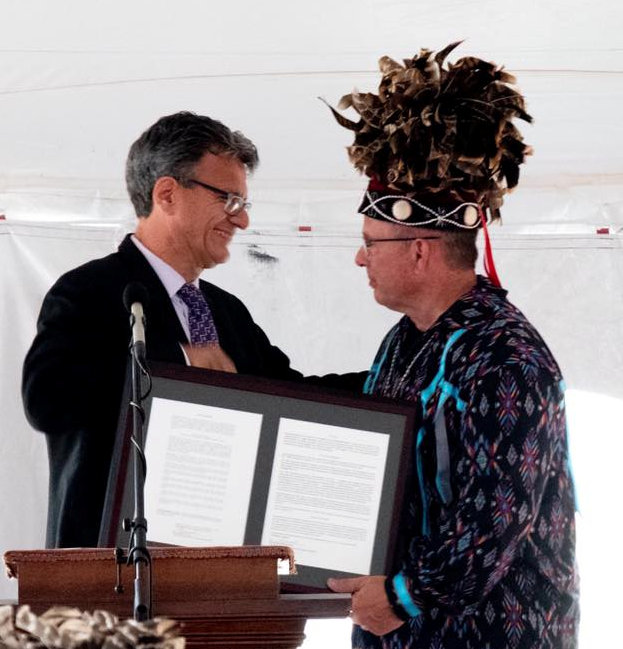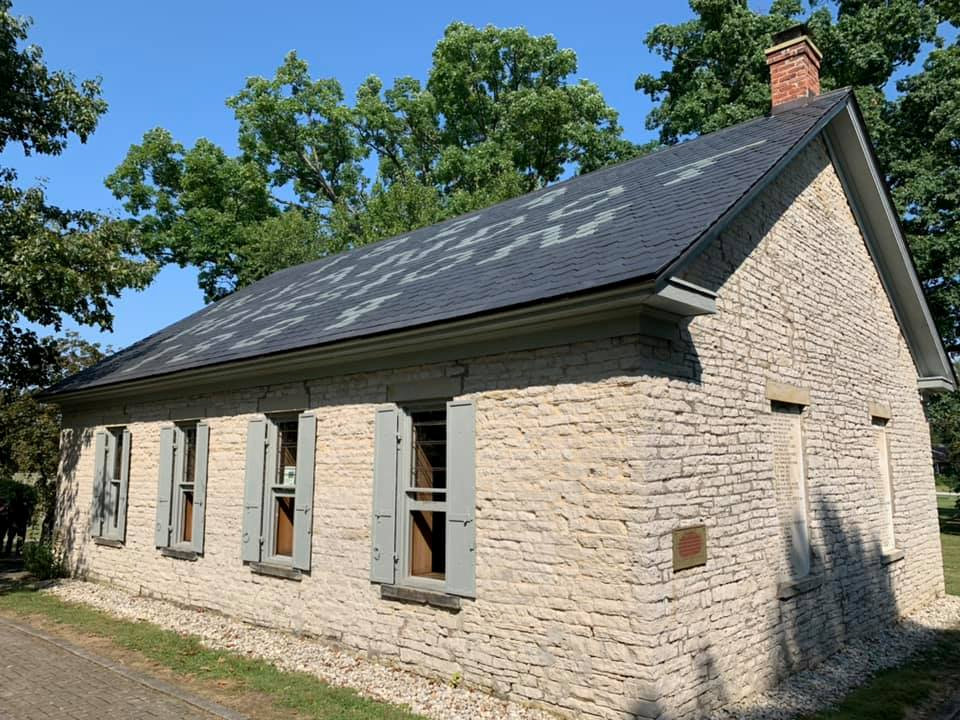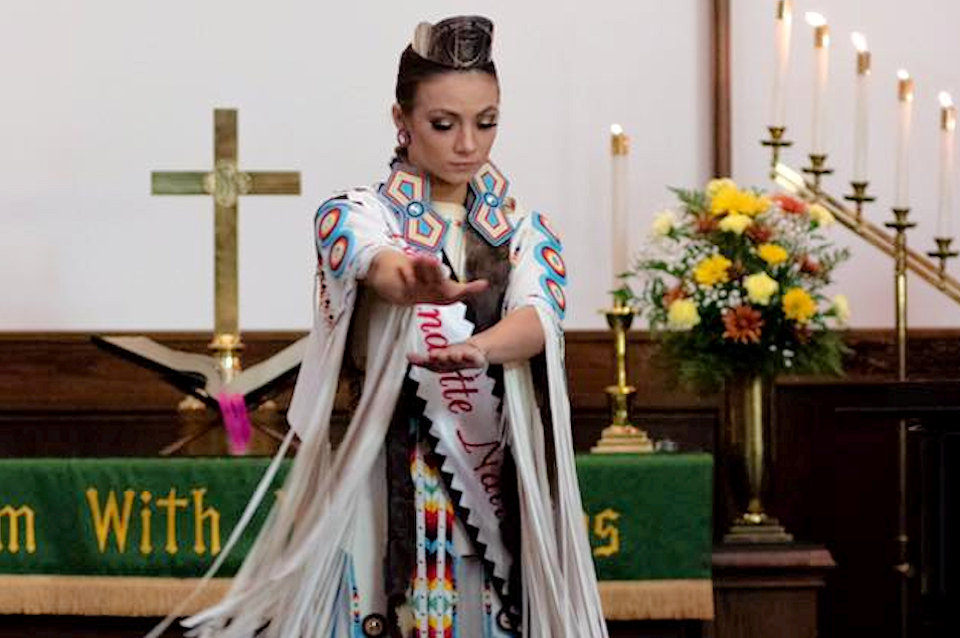There was drumming. There was dancing. There was much joy in Upper Sandusky, Ohio on September 21st as the United Methodist Church returned a deed to a historic worship site of the Wyandotte Nation.
KAY PANOVEC
West Ohio Conference

Imagine being forced to leave your home and everything familiar to you. Imagine leaving the place where you learned, gathered with friends and worshipped; where your ancestors were buried. This was the reality for 664 Wyandotte people when the United States government enforced the Indian Removal Act of 1830.
On September 21, that land including the Mission Church was returned to the Native Americans. The Wyandotte people had entrusted the land to the Methodist Church 176 years ago because of shared friendship and faith.
“Today is a monumental day for the Wyandotte people,” said Chief Billy Friend of the Wyandotte Nation of Oklahoma. “For the Methodist people to come to us and offer to give the land back to us, we are truly overjoyed.”
With tears in his eyes, Friend accepted the deed to the land from Thomas Kemper, general secretary of Global Ministries of The United Methodist Church. Nearly 600 people rose to their feet and applauded while Wyandotte from Oklahoma, Kansas, and Michigan lifted celebratory cries. Wyandotte children and youth – including Wyandotte Princess Sara Wright – danced, and Wyandotte men drummed.
The day began at the John Stewart United Methodist Church with a look back at the relationship between the Wyandotte and the Methodists.
First Methodist Missionary
John Stewart was born in Virginia to parents of mixed African and European descent. Plagued by illness throughout his life, Stewart experienced many difficulties traveling from Virginia to Ohio. He was robbed of his possessions, drank heavily and fought depression.
One night, after attending a Methodist camp meeting in Marietta, Ohio, Stewart received a calling from God to be faithful and tell others about God. Although he fought the calling, he vowed to commit himself to mission work among Native Americans. Traveling more than 200 miles to northwest Ohio, Stewart settled in what is now known as Upper Sandusky. He began his work with the Wyandotte people in 1816.
He was befriended by Jonathan Pointer, another person of African descent. Pointer, who lived with the Wyandotte people, translated Stewart’s messages. This resulted in friendship and religious conversion by Wyandotte chiefs and leading women in their community.
The Methodist Episcopal Church supported Stewart’s mission work financially and appointed missionaries to assist him. His work and example inspired the formation of the Methodist Missionary Society in 1820, the forerunner to today’s General Board of Global Ministries.
In 1845, a Methodist church (now a United Methodist church) was named in his honor.
“Members of the General Commission on Archives and History left our business meeting at Methodist Theological School of Ohio in order to have the privilege of being present for this historical event. After two of us were seated near the front of the sanctuary of John Stewart UMC, I spoke to the person next to me. He was a descendant of John Stewart! Many persons from the Wyandotte Nation, coming from Oklahoma, Kansas, and Michigan, were recognized. During the walk to the Mission area, you could feel God’s presence in the somberness of the cemetery, the comfort of the Mission Church, and in the prayers expressed during the ceremony held in a large tent. It was amazing to experience great joy as they received the deed to the mission area.” ~ Diana Spitnale Miller, Gladwin MI
Sharing the Story
In the 1960s, the Records and History Committee of the John Stewart United Methodist Church was formed to share the history of the Wyandotte and Methodists with students in the Upper Sandusky public schools. In 2007, Wyandotte high school and college students, along with local and national leaders of the Wyandotte Nation, visited the site for a day of immersion in Wyandotte language, culture, and history.
“It is an honor to know and share the history of this sacred place with all who visit. After 176 years, we close the circle as the land is returned to the Wyandotte,” said Pastor Betsy Bowen of John Stewart UMC and a member of the Records and History Committee. “It’s a good day to be a Wyandotte, and it’s a good day to be a United Methodist.”
Moving on toward hope
In 2012, The United Methodist Church began a new chapter in the church’s relationship with indigenous peoples. Since then, 26 conferences have either held an Act of Repentance or began a process to connect with indigenous peoples. The Michigan Annual Conference took first steps on this path toward wellness in 2016.
The Council of Bishops, represented by West Ohio Bishop Gregory V. Palmer and East Ohio Bishop Tracy Malone, reaffirm their commitment to work toward healing relationships and acknowledging the failings of the past and the present. Palmer and Malone committed to cultivating opportunities for advocacy, dialogue, repentance and participation in new and meaningful ways.
“This history has been both painful and tragic; yet, there has also been the triumph of human spirit by the grace of God coming out of that history. That grace has enabled people to heal, to be redeemed and to reconcile with one another, with God and with the land,” Palmer said.

The Global Ministries president, Wisconsin Conference Bishop Hee-Soo Jung, said the agency would continue supporting annual conference and Native American ministries; educating staff, churches and communities about the harms of Native American mascots and racism they perpetuate; and listening to and standing with Native Americans in their struggle for justice and full participation in society.
Together, chiefs and bishops clasped hands and prayed.
The Work Continues
Kemper expressed hope that that attendees would leave with a new commitment to cross boundaries in order to be in solidarity with Native American and indigenous sisters and brothers everywhere. “We also hope that each will take away a sense of mission from the margins from the example of missionary John Stewart, whose marginalized position in society allowed him a unique way of connecting with the Wyandotte people,” Kemper said.
Friend presented a $10,000 check to the Records and History Committee of John Stewart UMC for the continuing care and upkeep of the Mission Church.”It is a miracle the church is still standing,” Friend said. “We will be forever indebted to the local community for their commitment and hard work for the preservation and upkeep of this land. This will always be our church together.”
~ Reprinted with permission. Kay Panovec is the Director of Communications for the West Ohio Conference. Alfred T. Day, General Secretary of the General Commission of Archives and History, and Kay DeMoss, Michigan Conference Communications, contributed to this story.
Last Updated on November 1, 2023

